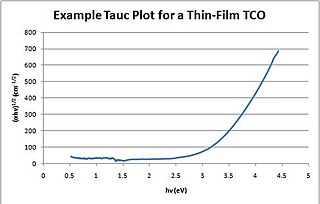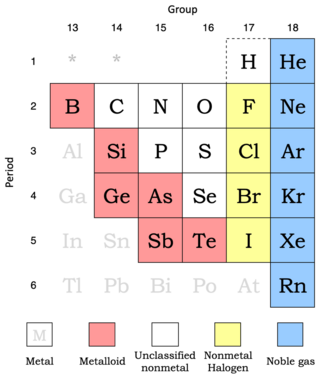Related Research Articles

Antimony is a chemical element; it has symbol Sb (from Latin stibium) and atomic number 51. A lustrous gray metalloid, it is found in nature mainly as the sulfide mineral stibnite (Sb2S3). Antimony compounds have been known since ancient times and were powdered for use as medicine and cosmetics, often known by the Arabic name kohl. The earliest known description of the metalloid in the West was written in 1540 by Vannoccio Biringuccio.
Photoconductivity is an optical and electrical phenomenon in which a material becomes more electrically conductive due to the absorption of electromagnetic radiation such as visible light, ultraviolet light, infrared light, or gamma radiation.
A metalloid is a type of chemical element which has a preponderance of properties in between, or that are a mixture of, those of metals and nonmetals. There is no standard definition of a metalloid and no complete agreement on which elements are metalloids. Despite the lack of specificity, the term remains in use in the literature of chemistry.

Nonmetals are chemical elements that mostly lacks distinctive metallic properties. They range from colorless gases like hydrogen to shiny crystals like iodine. Physically, they are usually lighter than metals; brittle or crumbly if solid: and often poor conductors of heat and electricity. Chemically, nonmetals have high electronegativity ; and their oxides tend to be acidic.

A pnictogen is any of the chemical elements in group 15 of the periodic table. Group 15 is also known as the nitrogen group or nitrogen family. Group 15 consists of the elements nitrogen (N), phosphorus (P), arsenic (As), antimony (Sb), bismuth (Bi), and moscovium (Mc).

A semimetal is a material with a very small overlap between the bottom of the conduction band and the top of the valence band. According to electronic band theory, solids can be classified as insulators, semiconductors, semimetals, or metals. In insulators and semiconductors the filled valence band is separated from an empty conduction band by a band gap. For insulators, the magnitude of the band gap is larger than that of a semiconductor. Because of the slight overlap between the conduction and valence bands, semimetals have no band gap and a negligible density of states at the Fermi level. A metal, by contrast, has an appreciable density of states at the Fermi level because the conduction band is partially filled.

Antimony trisulfide is found in nature as the crystalline mineral stibnite and the amorphous red mineral metastibnite. It is manufactured for use in safety matches, military ammunition, explosives and fireworks. It also is used in the production of ruby-colored glass and in plastics as a flame retardant. Historically the stibnite form was used as a grey pigment in paintings produced in the 16th century. In 1817, the dye and fabric chemist, John Mercer discovered the non-stoichiometric compound Antimony Orange, the first good orange pigment available for cotton fabric printing.
Chalcogenide glass is a glass containing one or more chalcogens. Up until recently, chalcogenide glasses (ChGs) were believed to be predominantly covalently bonded materials and classified as covalent network solids. A most recent and extremely comprehensive university study of more than 265 different ChG elemental compositions, representing 40 different elemental families now shows that the vast majority of chalcogenide glasses are more accurately defined as being predominantly bonded by the weaker van der Waals forces of atomic physics and more accurately classified as van der Waals network solids. They are not exclusively bonded by these weaker vdW forces, and do exhibit varying percentages of covalency, based upon their specific chemical makeup. Polonium is also a chalcogen but is not used because of its strong radioactivity. Chalcogenide materials behave rather differently from oxides, in particular their lower band gaps contribute to very dissimilar optical and electrical properties.

Copper indium gallium (di)selenide (CIGS) is a I-III-VI2 semiconductor material composed of copper, indium, gallium, and selenium. The material is a solid solution of copper indium selenide (often abbreviated "CIS") and copper gallium selenide. It has a chemical formula of CuIn1−xGaxSe2, where the value of x can vary from 0 (pure copper indium selenide) to 1 (pure copper gallium selenide). CIGS is a tetrahedrally bonded semiconductor, with the chalcopyrite crystal structure, and a bandgap varying continuously with x from about 1.0 eV (for copper indium selenide) to about 1.7 eV (for copper gallium selenide).
GeSbTe (germanium-antimony-tellurium or GST) is a phase-change material from the group of chalcogenide glasses used in rewritable optical discs and phase-change memory applications. Its recrystallization time is 20 nanoseconds, allowing bitrates of up to 35 Mbit/s to be written and direct overwrite capability up to 106 cycles. It is suitable for land-groove recording formats. It is often used in rewritable DVDs. New phase-change memories are possible using n-doped GeSbTe semiconductor. The melting point of the alloy is about 600 °C (900 K) and the crystallization temperature is between 100 and 150 °C.

Antimony trichloride is the chemical compound with the formula SbCl3. It is a soft colorless solid with a pungent odor and was known to alchemists as butter of antimony.

Bismuth chloride (or butter of bismuth) is an inorganic compound with the chemical formula BiCl3. It is a covalent compound and is the common source of the Bi3+ ion. In the gas phase and in the crystal, the species adopts a pyramidal structure, in accord with VSEPR theory.

A Tauc plot is used to determine the optical bandgap, or Tauc bandgap, of either disordered or amorphous semiconductors.

Compounds of lead exist with lead in two main oxidation states: +2 and +4. The former is more common. Inorganic lead(IV) compounds are typically strong oxidants or exist only in highly acidic solutions.
The chemical elements can be broadly divided into metals, metalloids, and nonmetals according to their shared physical and chemical properties. All metals have a shiny appearance ; are good conductors of heat and electricity; form alloys with other metals; and have at least one basic oxide. Metalloids are metallic-looking brittle solids that are either semiconductors or exist in semiconducting forms, and have amphoteric or weakly acidic oxides. Typical nonmetals have a dull, coloured or colourless appearance; are brittle when solid; are poor conductors of heat and electricity; and have acidic oxides. Most or some elements in each category share a range of other properties; a few elements have properties that are either anomalous given their category, or otherwise extraordinary.

The metallic elements in the periodic table located between the transition metals to their left and the chemically weak nonmetallic metalloids to their right have received many names in the literature, such as post-transition metals, poor metals, other metals, p-block metals and chemically weak metals. The most common name, post-transition metals, is generally used in this article.
Bismuth antimonides, Bismuth-antimonys, or Bismuth-antimony alloys, (Bi1−xSbx) are binary alloys of bismuth and antimony in various ratios.

Nonmetals show more variability in their properties than do metals. Metalloids are included here since they behave predominately as chemically weak nonmetals.
Gallium compounds are compounds containing the element gallium. These compounds are found primarily in the +3 oxidation state. The +1 oxidation state is also found in some compounds, although it is less common than it is for gallium's heavier congeners indium and thallium. For example, the very stable GaCl2 contains both gallium(I) and gallium(III) and can be formulated as GaIGaIIICl4; in contrast, the monochloride is unstable above 0 °C, disproportionating into elemental gallium and gallium(III) chloride. Compounds containing Ga–Ga bonds are true gallium(II) compounds, such as GaS (which can be formulated as Ga24+(S2−)2) and the dioxan complex Ga2Cl4(C4H8O2)2. There are also compounds of gallium with negative oxidation states, ranging from -5 to -1, most of these compounds being magnesium gallides (MgxGay).
References
- 1 2 Allan C. Topp (1939). Studies on Explosive Antimony and Antimony Tetrachloride Solutions. Dalhousie University . Retrieved 2016-11-21.
- 1 2 N.C. Norman (1997). Chemistry of Arsenic, Antimony and Bismuth. Springer Science & Business Media. p. 50. ISBN 9780751403893 . Retrieved 2016-11-21.
Another possible allotrope, known as explosive antimony, has been reported which is produced by electrolysis of antimony chloride, iodide or bromide and is believed to be in a strained amorphous state.
- 1 2 Otfried Madelung (2012). Semiconductors: Data Handbook. Springer Science & Business Media. p. 408. ISBN 9783642188657 . Retrieved 2016-11-21.
Explosive Antimony is only metastable and transforms into metallic antimony during mechanical stress and heating. Explosive Antimony is probably not an allotropic form, but a mixed polymer.
- 1 2 Egon Wiberg, Nils Wiberg (2001). Inorganic Chemistry. Academic Press. p. 758. ISBN 9780123526519 . Retrieved 2016-11-21.
- ↑ Bernard Martel (2004). Chemical Risk Analysis: A Practical Handbook. Butterworth-Heinemann. ISBN 9780080529042 . Retrieved 2016-11-21.
- ↑ James H. Walton Jr. (July 1913). "Suspended changes in Nature". Popular Science. p. 31. Retrieved 2016-11-21.
We are indebted to the investigations of Professor Cohen for a more striking example of a metastable metal, that of the " explosive " antimony. By passing an electric current through a solution of antimony chloride this metal may be deposited in the form of a thick metallic coating.
- ↑ C.C. Coffin, Stuart Johnston (1934-10-01). "Studies on Explosive Antimony. I. The Microscopy of Polished Surfaces". Proceedings of the Royal Society of London. JSTOR 2935608.
- ↑ C.C. Coffin (1935-10-15). "Studies on Explosive Antimony. II. Its Structure, Electrical Conductivity, and Rate of Crystallization" (PDF). Proceedings of the Royal Society of London. pp. 47–63. Archived from the original (PDF) on 2016-09-12. Retrieved 2016-11-21.
- ↑ F. M. Aymerich, A. Delunas (1975-09-16). "On the explosive semiconductor-semimetal transition of antimony". Physica Status Solidi A. 31 (1). Physica Status Solidi: 165–170. Bibcode:1975PSSAR..31Q.165A. doi:10.1002/pssa.2210310118.
The energy released by this transition, is measured to be 24 cal per gram of amorphous Sb and is shown to be related to a variation of the mass density and of the conductivity behaviour of Sb going from one configuration to the other. A simple theoretical model is outlined which quite satisfactory gives the gross features of the free-energy diagram of the above transition, although more deep investigation is needed to account for the energy balance of it.